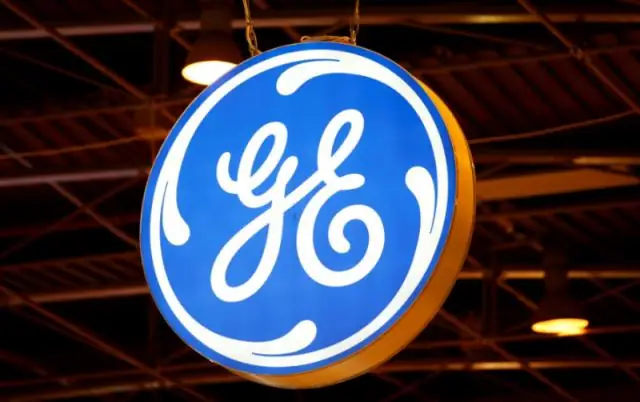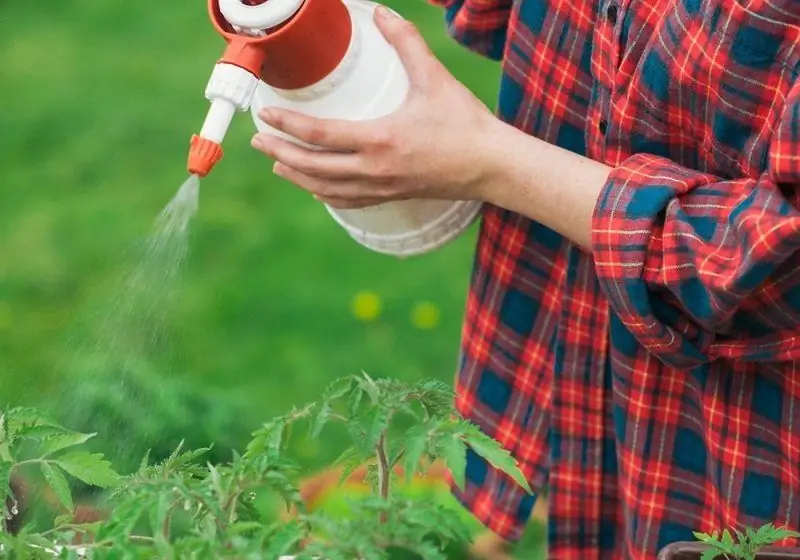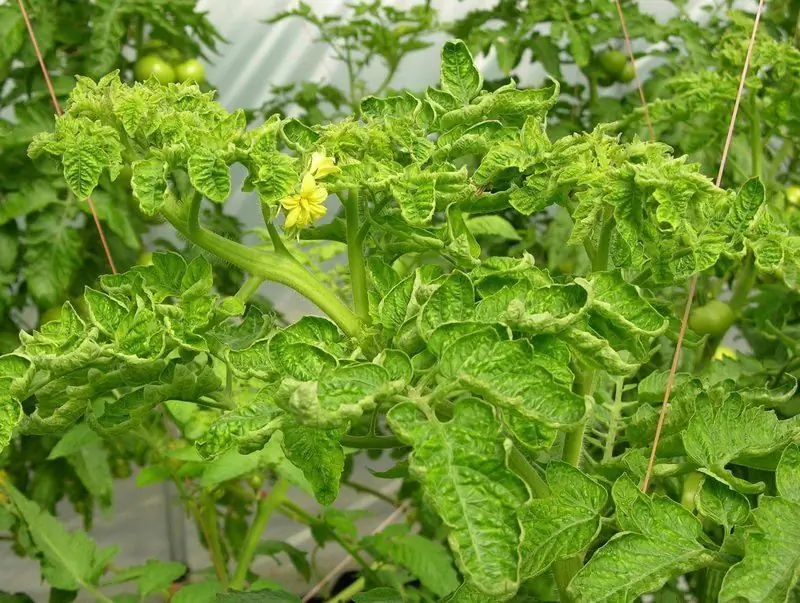
Table of contents:
- Author Bailey Albertson [email protected].
- Public 2023-12-17 12:53.
- Last modified 2025-06-01 07:32.
Why do tomatoes crack on a bush and how to avoid it

Tomatoes cracked right on the bush upset any summer resident. Indeed, in this case, not only the appearance of the fruit suffers, but also there is a real threat of crop loss, since bacteria and pathogenic fungi, as well as insects, easily penetrate into the cracks.
Why do tomatoes crack and burst (in open ground and in a greenhouse)
Cracking of tomatoes is usually not infectious; this phenomenon occurs for other reasons, most of them associated with errors in agricultural technology:
-
Wrong watering regime. During a drought, the plant stops developing, while the skin on the fruits becomes tanned. Subsequent excessive abundant moisture leads to a sharp jump in growth, when the crop seeks to absorb as much moisture as possible at once. The pulp grows faster than the hardened peel, which does not have time to grow and cracks. In the open field, the same phenomenon is caused by prolonged downpours, which replaced the dry period.

Green tomatoes Even unripe green tomatoes crack from improper watering
- Sharp temperature jumps. During the heat, and the temperature in the greenhouse can reach + 45 … + 50 ° C, the vegetable crop inhibits growth and discards the ovary. When conditions become comfortable again, the plant and the fruits on it begin to develop and grow again. At the same time, the hard crust prevents the active build-up of mass by the pulp and gives cracks.
-
Excessive pinching and leaf removal. Moisture, originally intended for the growing tops, stepsons and lower leaves (they are sometimes removed without measure by zealous summer residents), goes to the fruits. The increased pressure naturally leads to the appearance of ruptures and cracks on their surface.

Stealing Excessive one-time pinching is also fraught with cracking of the fruit.
- Incorrect feeding. With an excessive content of mineral fertilizers in the soil, especially nitrogen, the rate of fruit filling is sharply accelerated. The skin does not have time to fully form, it is too thin and easily injured. Lack or untimely application that does not correspond to a certain period of development leads to the same result.
-
Infections. In rare cases, the cause of the appearance of cracks are dangerous diseases (late blight, apical and gray rot, alternaria, etc.).

Disease Sometimes tomatoes crack due to disease
-
Genetic predisposition. Some tomato varieties are more prone to cracking than others:
- orange and yellow;
- ultra early ripening with a thin skin;
- large-fruited salad.
- Incorrect selection of varieties. Tomatoes bred for greenhouses in open ground usually grow poorly, reacting inadequately to care (there are few fruits, they are gnarled or cracked).
How to deal with the problem
There is nothing you can do about already cracked tomatoes. Small cracks scar themselves, forming a dark dense tissue that prevents infection from entering the fetus. It is recommended to pick and eat damaged tomatoes or use them for preservation.
In this situation, only preventive measures are effective:
-
Organization of competent watering. The soil under the tomatoes should always be moist. In hot weather, they are watered after 2-3 days, spending about 3-4 liters of water for each specimen. In cloudy weather, one humidification every 5-6 days will be enough. If it rains for a long time, then planting in open ground should be covered with a canopy or film. After the drought that has occurred, you cannot immediately give a lot of water, this is done in small portions. You cannot water in the heat; it is better to postpone it for the evening (22-23 hours), when the heat subsides. After a night cold snap (below +13 ° C), you need to wait for the greenhouse to warm up.

Drip irrigation The organization of drip irrigation will avoid drying out the soil
- Mulching. To retain moisture in the ground and reduce irrigation, you need to lay mulch from cut grass, straw, sawdust, etc.
- Temperature control. Tomatoes are most comfortable at + 16 … + 18 ° C at night and + 22 … + 24 ° C during the day. You can cool the air in the greenhouse by spraying, installing containers with water, etc.
-
Airing. Fresh air must be constantly supplied to the room.

Airing The greenhouse must be regularly ventilated, and in the heat, the vents and doors must be kept open constantly
- Shading. To protect from the scalding rays of the sun, a special net or awning is pulled, the roof and walls of the greenhouse are covered with milk of lime.
- Sparing pinching. The stepsons are removed gradually, about once a week.
- Correct feeding. Fertilize every 10-15 days on schedule (at planting, during flowering and during ripening).
When we established drip irrigation in our greenhouse, the problems with tomatoes became much less. Small portions of moisture constantly supplied directly to the roots eliminated the need to monitor soil moisture.
Video: why tomatoes burst in the garden
Proper care of tomato beds throughout the growing season, which consists in organizing regular and correct moisture, temperature control, shading, mulching, applying appropriate fertilizers, as well as other care manipulations, will avoid the appearance of ugly cracks on the fruits.
Recommended:
How To Pinch Tomatoes Correctly In A Greenhouse And Open Ground (video, Photo, Diagram), Which Varieties Do Not Require Pinning

Practical advice for pinching tomatoes of different varieties. Pinion schemes for the formation of a bush in one, two and three stems
Gladioli In The Open Field: Planting And Care, When To Plant And Not Only

Advice on growing, caring for gladioli, collecting and storing bulbs - adults and children. Tuber planting schemes, variety selection
Spraying Tomatoes From Late Blight In The Greenhouse And Open Field

What is late blight and what does it look like. Preventive spraying of tomatoes with folk remedies. Treatments with biologicals and inorganic fungicides
How To Tie Up Cucumbers In The Greenhouse And Open Field

What are the benefits of a garter of cucumbers, what problems it relieves. Universal rules. Habitual and non-standard ways of tying + photos, videos
The Tops Of Tomatoes In The Greenhouse And Open Ground Are Curling Up: What To Do

Why do tomatoes have curly tops (in a greenhouse or open ground): care errors, diseases, pests. Ways to solve these problems
